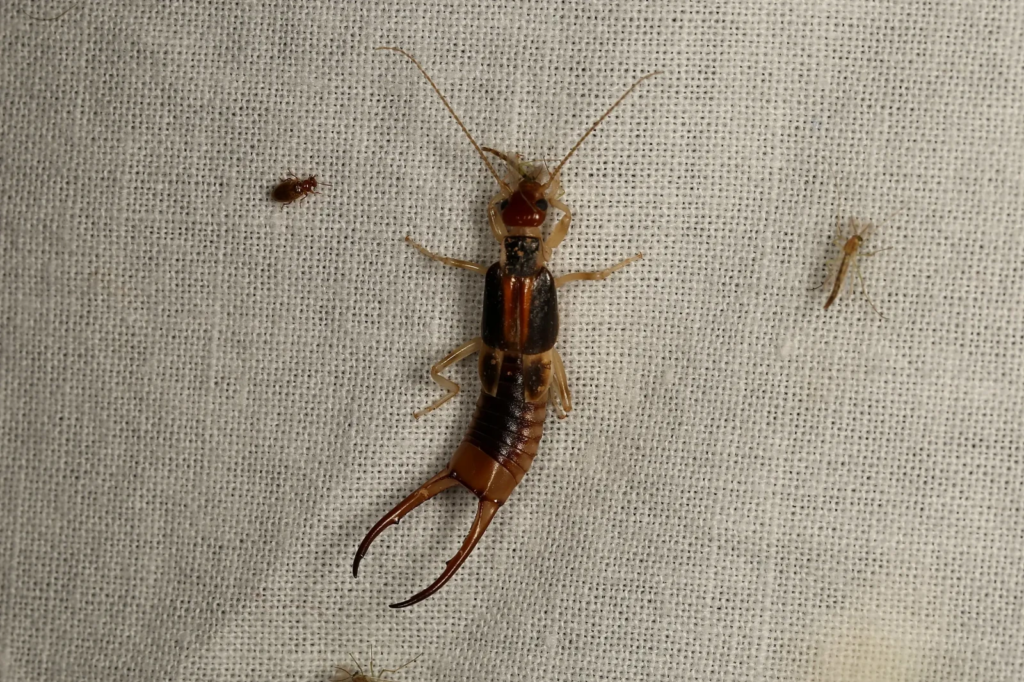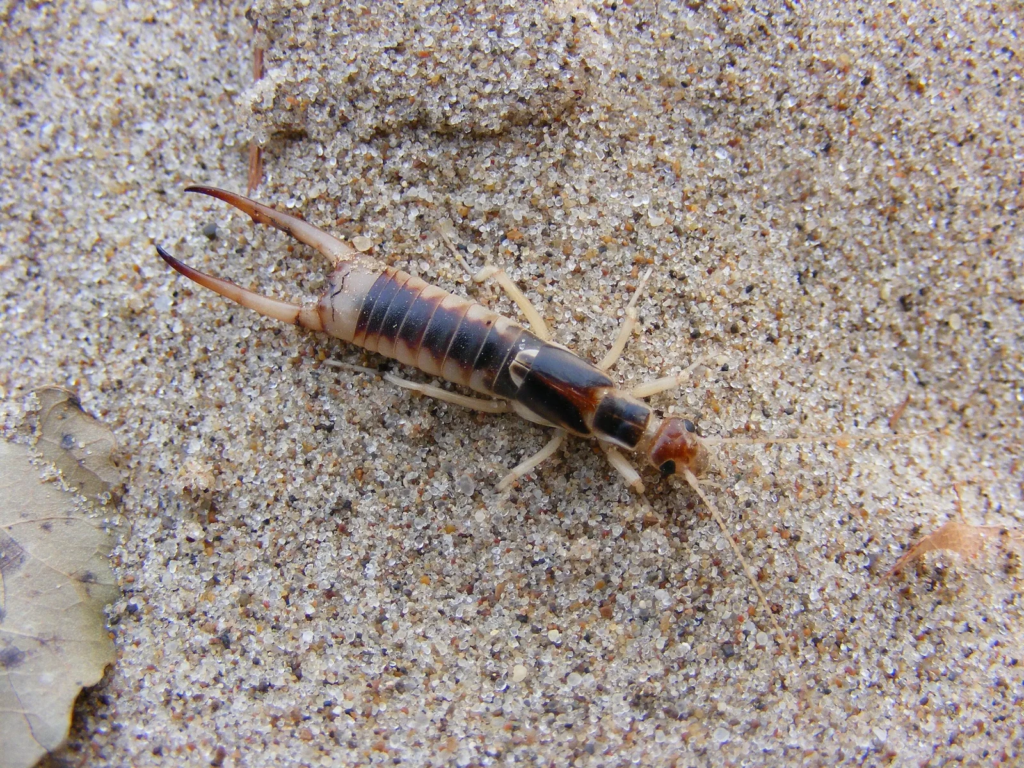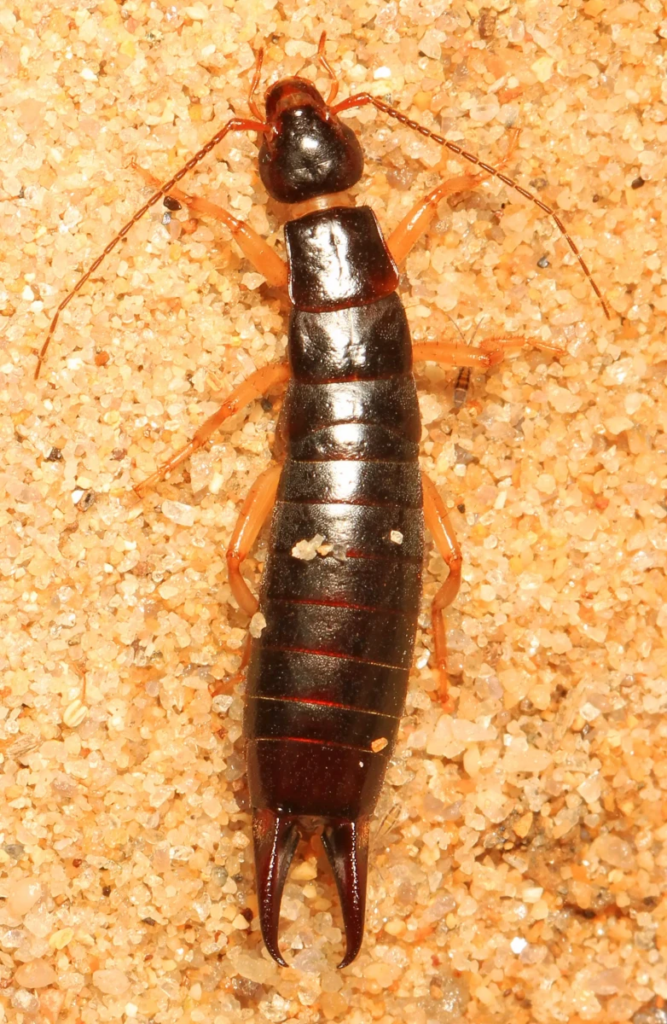Earwigs are common household pests often misunderstood and surrounded by urban legends. Despite being harmless to humans, as they do not bite or transmit diseases, their presence can still be unsettling.
While earwigs tend to stick more to the outdoors, they often find their way inside your home and show up in all sorts of unwanted places. So, let’s go over not only how to get rid of earwigs but how to prevent them from becoming a problem for you in the first place. If you’ve got earwig problems or you need some earwig prevention, contact us for a free quote or click here to see pricing.
Key Takeaways
- Earwigs are not dangerous to humans.
- Earwig infestations are often related to moisture issues.
- Vinx Pest Control provides effective earwig control solutions.
- Understanding earwig behavior is key to controlling them.
- Professional pest control services can help manage earwig infestations.
- Earwig control methods include eliminating moisture and clutter.
Understanding Earwigs: Know Your Enemy
Earwigs are often misunderstood creatures that require a closer look to comprehend their behavior and characteristics. Despite their fearsome appearance, they are generally harmless to humans and play a significant role in the ecosystem.
What Are Earwigs?
Earwigs belong to the order Dermaptera, characterized by their elongated, flat bodies and distinctive pincers at the end of their abdomen. These insects are nocturnal, preferring dark, moist environments.

Physical Characteristics and Identification
Earwigs are easily identifiable due to their unique appearance. They have a pair of cerci, or pincers, which they use for defense, capturing prey, and other functions. Adult earwigs typically range in length from 1/4 to 1 inch.
The lifecycle of an earwig includes several stages: egg, nymph, and adult. Female earwigs are known to be attentive parents, guarding their eggs and nymphs until they mature. This complex lifecycle is crucial for understanding how to manage earwig populations.
Common Myths About Earwigs
Many myths surround earwigs, including the belief that they crawl into human ears. This myth is largely unfounded, as earwigs are not attracted to human ears or brains. They are primarily focused on feeding on decaying matter, plants, and other insects.
Do Earwigs Bite? The Truth About These Insects
Earwigs are capable of pinching with their cerci, but they rarely bite humans. When they do pinch, it’s usually in defense and is not typically painful. Understanding that earwigs are not aggressive towards humans can help alleviate unnecessary fear.
Signs of an Earwig Infestation
Earwig infestations are more common than you think, and knowing the signs can help you tackle the problem effectively. Earwigs are nocturnal insects that thrive in moist environments, making both indoor and outdoor areas susceptible to infestation.
Visual Identification of Earwigs
To identify an earwig infestation, it’s crucial to know what earwigs look like. Earwigs are elongated, flat insects with a pair of pincers at their rear. They are usually brown or black and can range in size. Visual identification is key to confirming their presence.

Common Areas Where Earwigs Hide
Earwigs prefer hiding in damp, dark areas. Understanding their preferred hiding spots can help you detect an infestation early.
Indoor Hiding Spots
Indoors, earwigs are often found in basements, bathrooms, and kitchens, particularly near sinks and dishwashers where moisture is prevalent. They also hide in cluttered areas, such as storage boxes and piles of paper.
Outdoor Hiding Spots
Outdoors, earwigs hide under rocks, mulch, and debris. They are also found in gardens, especially in moist soil and near decaying organic matter. Gardens with dense vegetation or near water sources are particularly attractive to earwigs.
Why Earwigs Invade Your Home and Garden
To tackle the problem of earwigs in your home and garden, it’s essential to understand what draws them to these areas. Earwigs are not random invaders; their presence is often a result of specific environmental conditions.
Environmental Factors That Attract Earwigs
Earwigs are attracted to certain environmental factors that make your home and garden appealing to them. Two significant factors are moisture and humidity. Earwigs thrive in damp environments, which is why you often find them in areas with high humidity levels.
Moisture and Humidity
High moisture levels in your home or garden can attract earwigs. This moisture can come from various sources, including leaking pipes, poor drainage, and excessive watering of plants. Ensuring that your home is dry and well-ventilated can help deter earwigs.
Food Sources for Earwigs
Earwigs are also drawn to available food sources. They feed on decaying organic matter, fungi, and even certain types of plants. Keeping your garden free of debris and managing your plants’ health can reduce the attractiveness of your garden to earwigs.
Seasonal Patterns of Earwig Activity
Earwig activity can vary significantly with seasonal changes. Understanding these patterns can help you anticipate and prepare for potential invasions. Generally, earwigs are more active during warmer months when moisture levels are higher.
During the spring and summer, earwigs are more likely to be seen as they search for food and mates. As the weather cools in the fall, they tend to seek sheltered locations to overwinter, often invading homes and other protected areas.
How to Get Rid of Earwigs Effectively
The key to eliminating earwigs lies in creating an environment that discourages their presence. Effective earwig control involves a combination of initial steps and long-term strategies to ensure these pests do not return.
Initial Steps for Earwig Control
To start controlling earwigs, it’s essential to take immediate actions and assess the severity of the infestation.
Immediate Actions to Take
Upon identifying an earwig infestation, the first step is to clean up debris and clutter around the home and garden. Earwigs thrive in moist, cluttered environments, so removing their hiding spots is crucial. This includes disposing of decaying organic matter, old newspapers, and cardboard boxes.
Assessing the Severity of Infestation
Assessing the extent of the earwig infestation is vital to determine the appropriate control measures. Check for earwigs in damp areas, under sinks, and near plants. The presence of earwigs during the day is a sign of a severe infestation, as they are typically nocturnal.
Creating an Earwig-Hostile Environment
To effectively get rid of earwigs, it’s necessary to create an environment that is not conducive to their survival. This involves reducing moisture and eliminating food sources.

Reducing Moisture and Humidity
Earwigs are attracted to moist environments. Reducing humidity around the home and garden can be achieved by fixing leaks, improving drainage, and using dehumidifiers. This makes the area less appealing to earwigs.
Earwigs feed on decaying organic matter, fungi, and other insects. Eliminating their food sources involves maintaining a clean garden, disposing of rotting vegetation, and using mulch wisely. By reducing the availability of food, you can discourage earwigs from inhabiting the area.
By following these initial steps and creating an earwig-hostile environment, you can effectively control earwig infestations and prevent future occurrences.
Natural Earwig Repellents and Solutions
Nature provides several effective solutions to repel earwigs without resorting to harsh chemicals. For homeowners and gardeners looking for alternatives to chemical pesticides, natural earwig repellents offer a viable and environmentally friendly option.
DIY Earwig Remedies That Actually Work
Several DIY remedies can effectively deter earwigs from your home and garden. One popular method involves using damp newspaper or cardboard traps. Earwigs are attracted to the moisture and will gather under these traps, allowing for easy disposal.
Another effective DIY remedy is the use of soap solution. Mixing dish soap with water in a spray bottle can create a solution that repels earwigs upon contact. Spraying this solution around entry points and areas of earwig activity can help control their population.
Essential Oils and Plant-Based Repellents
Essential oils have gained popularity for their pest-repelling properties, including against earwigs. Certain oils can be used to create a repellent that is safe for use around pets and children.
Most Effective Essential Oils Against Earwigs
Lavender oil, peppermint oil, and tea tree oil are among the most effective essential oils for repelling earwigs. These oils can be used individually or in combination to enhance their repellent effect.
Application Methods for Natural Repellents
To apply essential oils effectively, they should be diluted with water or a carrier oil to avoid overpowering the area. Spraying the diluted solution around the perimeter of your home and in areas where earwigs are spotted can help deter them.
Homemade Earwig Repellent Recipes
Creating homemade earwig repellents can be a fun and effective way to manage earwig infestations. One simple recipe involves mixing equal parts of water and white vinegar in a spray bottle. Adding a few drops of essential oils like lavender or peppermint can enhance the repellent properties.
Another recipe includes using citrus peels. Boiling citrus peels in water and then using the cooled solution as a spray can repel earwigs. This method is also environmentally friendly and safe for use around pets.
Trap and Kill Earwigs: Effective Methods
Trapping earwigs can be an effective way to control their population in your home and garden. By using the right traps, you can capture and eliminate these pests, reducing the risk of infestation.
DIY Earwig Traps
DIY earwig traps are a cost-effective and easy-to-implement solution. Two popular methods include:
Oil and Soy Sauce Trap
Mixing oil and soy sauce creates a potent trap. Earwigs are attracted to the smell and get trapped in the mixture. To make this trap, combine equal parts of oil and soy sauce in a shallow container. Place it near areas where earwigs are commonly found.
Rolled Newspaper Trap
Rolled newspapers can also be used to trap earwigs. Earwigs seek shelter in dark, moist areas, and rolled newspapers provide an ideal hiding spot. Simply roll up a few newspapers, tie them with a string, and place them in areas where earwigs are present. Dispose of the trapped earwigs in the morning.
Commercial Trapping Solutions
For more severe infestations, commercial trapping solutions can be effective. These traps are specifically designed to capture earwigs and can be more efficient than DIY methods. Look for traps that use attractants or pheromones to lure earwigs.
When and Where to Place Earwig Traps
The placement of earwig traps is crucial for their effectiveness. Place traps in areas where earwigs are most active, such as near plants, in damp areas, or near entry points to your home. Traps should be placed in the evening, as earwigs are nocturnal.
By using a combination of DIY and commercial trapping solutions, you can effectively control earwig populations and prevent future infestations.

Chemical Solutions for Severe Earwig Infestations
Severe earwig infestations often require more aggressive treatments, such as chemical solutions. While it’s preferable to manage earwig populations using natural and non-toxic methods, severe cases may necessitate the use of chemical insecticides to effectively control the infestation.
Over-the-Counter Insecticides for Earwigs
For homeowners dealing with severe earwig infestations, over-the-counter (OTC) insecticides can provide a readily available solution. These products come in various forms, including sprays, dusts, baits, and granules, each with its own application method and effectiveness.
Sprays and Dusts
Sprays and dusts are commonly used OTC insecticides for earwig control. Sprays can be applied directly to areas where earwigs are seen or hiding, while dusts are often used in crawl spaces, attics, or other areas where earwigs may be present. Products containing pyrethroids or permethrin are typically effective against earwigs.
Baits and Granules
Baits and granules offer another effective method for controlling earwigs. Baits are designed to be carried back to the earwigs’ nests, killing the insects at their source. Granules are often spread around the perimeter of homes or in gardens to create a barrier against earwigs. When using baits or granules, it’s essential to follow the product instructions carefully to ensure effectiveness and safety.
Professional-Grade Chemical Treatments
In cases where OTC insecticides are not sufficient or the infestation is particularly severe, professional-grade chemical treatments may be necessary. These treatments are typically available through pest control professionals who have access to more potent insecticides not available to the general public.
Professional-grade treatments can offer a more effective and longer-lasting solution to earwig infestations. However, they require the expertise of a licensed pest control professional to ensure safe and effective application.
Safety Precautions When Using Chemicals
When using chemical solutions to control earwig infestations, safety precautions are paramount. Always read and follow the label instructions on any insecticide product. Wear protective clothing, including gloves and eyewear, to minimize exposure. Keep children and pets away from treated areas until the product has dried or as directed by the product label.
It’s also crucial to consider the environmental impact of chemical treatments. Choose products with lower toxicity to non-target organisms and follow application guidelines to minimize drift or runoff into water sources or other sensitive areas.

Getting Rid of Earwigs in Specific Areas
Different regions of your home and garden demand distinct approaches to earwig control. Effective elimination requires understanding the specific areas where earwigs are most active.
Eliminating Earwigs Indoors
Indoor earwig control involves identifying and sealing entry points, reducing moisture, and eliminating hiding spots. Earwigs often hide in damp, dark areas.
Bathroom and Kitchen Strategies
In bathrooms and kitchens, focus on reducing humidity and fixing any leaks. Use a dehumidifier to keep the air dry, making these areas less appealing to earwigs. Ensure that all food is stored in sealed containers and clean up any spills promptly.
Basements and crawlspaces are common earwig hiding spots due to their typically damp conditions. Improve ventilation, use a dehumidifier, and seal any cracks or crevices to prevent earwig infestations.
Getting Rid of Earwigs in the Garden
Garden earwig control involves modifying the environment to discourage earwig presence. Earwigs are attracted to moist areas with plenty of hiding spots.
Flower Bed Protection Strategies
To protect flower beds, remove debris and weeds that provide shelter for earwigs. Improve drainage to reduce moisture, and consider using earwig repellents around the perimeter of your garden beds.
Protecting Potted Plants from Earwigs
Potted plant protection is crucial as earwigs can hide in the soil and under the pots. Use a well-draining potting mix, and avoid overwatering, which can attract earwigs. Consider using earwig repellents around the pots.

Preventing Future Earwig Infestations
Preventing future earwig infestations requires a multi-faceted approach that includes home maintenance, landscaping practices, and seasonal strategies. By adopting these measures, you can significantly reduce the likelihood of earwigs invading your home and garden.
Home Maintenance to Deter Earwigs
Maintaining your home is crucial in preventing earwig infestations. Two key aspects of home maintenance are sealing entry points and managing exterior lighting.
Sealing Entry Points
Earwigs can squeeze through tiny cracks and crevices, so it’s essential to seal all potential entry points around your home. Inspect your home’s foundation, windows, and doors for any gaps or holes, and seal them using caulk or weatherstripping.
Managing Exterior Lighting
Earwigs are attracted to light, so adjusting your exterior lighting can help deter them. Consider replacing traditional light bulbs with yellow or sodium vapor lights, which are less attractive to earwigs and other insects.
Landscaping Practices That Repel Earwigs
Landscaping practices can also play a significant role in preventing earwig infestations. By modifying your garden and yard, you can make it less appealing to earwigs.
Some effective landscaping practices include removing debris and clutter, improving drainage, and using earwig-repellent plants such as mint, basil, or chamomile.
Seasonal Prevention Strategies
Earwig activity varies with the seasons, so it’s essential to adapt your prevention strategies accordingly.
Spring Preparation
In the spring, earwigs begin to emerge from their winter hiding spots. To prevent infestations, inspect your home and garden for signs of earwigs, and take action to seal any entry points and remove debris.
Fall Cleanup to Prevent Overwintering
In the fall, earwigs start to look for sheltered spots to overwinter. To prevent them from settling in your home or garden, clean up debris, remove weeds, and seal any potential entry points.
When to Call Professional Pest Control
For severe or persistent earwig infestations, professional pest control services offer a reliable solution when DIY methods fall short.
While DIY methods can be effective for minor earwig infestations, there are instances where these approaches may not be sufficient. Understanding when to seek professional help is crucial for effectively managing an earwig problem.

Signs That DIY Methods Aren’t Working
If you’ve been using DIY methods to control earwigs but still notice a significant presence, it’s a clear indication that these methods aren’t working. Signs include continued sightings of earwigs in your home or garden, despite your best efforts to eliminate them.
Other indicators that DIY methods are failing include finding earwigs in various areas of your home, damage to plants, or an increase in earwig numbers over time.
What to Expect from Professional Earwig Treatment
Professional pest control services for earwigs typically begin with a thorough inspection of your property to identify the extent of the infestation and the factors contributing to it.
Based on the inspection findings, professionals will develop a customized treatment plan that may include a combination of traps, insecticides, and exclusion methods to effectively eliminate the earwigs and prevent future infestations.
Professional services also offer guidance on how to earwig-proof your home and garden, providing you with long-term solutions to prevent re-infestation.
Conclusion
If home remedies haven’t worked for you or you’re still feeling overtaken by unwanted pests of any kind, give Vinx Pest Control a call. Our experienced technicians are skilled at what they do and are trained to keep your family safe from any pest or rodent infestation. If you live in the Dallas, Charleston, or Greenville areas, we can help you with your pest control needs. Around Dallas, we serve Grapevine, Arlington, and Garland. In Charleston, we serve North Charleston and Mount Pleasant. In the Greenville area, we serve Greer, Spartanburg, and more.



